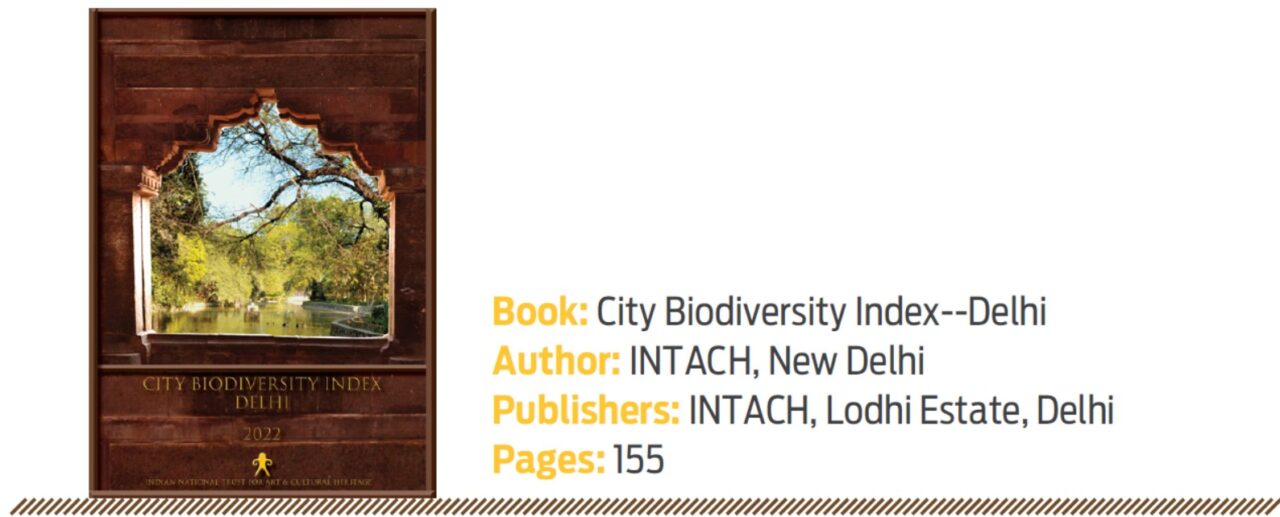What is the proportion of natural areas in India’s ever-burgeoning capital? It is just 13.16% of the total area of Delhi which has innumerable sky-scrappers all over. But you would be glad to know that the vascular plant species and bird species in the worst polluted city have increased substantially in spite of the built environment.
Amidst the challenges of overpopulation and perennial air quality issues, the national capital boasts a notable increase of 96 tree species, fostering a growth of 152 avian species. This positive ecological shift suggests that certain plant species are thriving, offering direct or indirect refuge to the diverse bird population in this heavily criticized metropolis.

The book under review may not exactly look like a traditional book but is a highly useful publication in book form, making available research studies of the urban biodiversity of Delhi. The Indian National Trust for Art and Cultural Heritage (INTACH) should be commended for not only sharing their detailed research but also for publishing this book (index) with a plethora of information unknown so far to the residents of the international city, as well as for those interested in issues of environment and urban biodiversity.
The principal author of this publication is Manu Bhatnagar, who is an architect by training but is an expert on rivers and natural heritage. He heads the natural heritage division of INTACH as its principal director. He says that the ‘City Biodiversity Index (CBI) is a self-assessment tool for cities to evaluate and monitor the progress of their biodiversity conservation efforts against their own individual baselines’.
This publication highlights the city’s strengths and areas requiring attention for the preservation of natural spaces crucial for human well-being. Using Delhi’s 2019-20 baseline, INTACH’s team computes various indicators to provide measurable results, ensuring the protection and potential growth of these areas amidst population and environmental pressures.
Cities like Nagpur, Indore, Bhopal, Kochi, and Hyderabad have conducted urban biodiversity studies, revealing the decline in global urban biodiversity. Tapping the negative trends, the Convention on Biological Diversity (CBD-2010), a UN body, proposed the idea of establishing the City Biodiversity Index, the book says, adding ‘the concern was expressed and discussed at length at the Conference of Parties (CoP) in 2002’.
Urban biodiversity is the diversity of life in and around cities, encompassing genetic, species, and habitat variety. Rapid urbanization adversely affects biodiversity and habitats. According to the authors, people who are dependent on ecological services supported by biodiversity also suffer from declining green and water cover.
Singapore pioneered the Urban Biodiversity Index, known as the ‘Singapore Index on City Biodiversity.’ Adopted globally, cities like Bangkok, Brussels, Edinburgh, Nagoya, London, and Montreal have assessed their biodiversity since 2019, using this method to conserve urban biodiversity.
The Delhi book informs us that ‘The urban environs of Delhi, although subjected to strong human influence and planning decisions that have profoundly impacted its native biodiversity, still retain considerable native biodiversity’.
Protecting biodiversity yields direct benefits like fishing, harvesting fruits, herbs, and nectars. Additionally, it safeguards surface and underground water, emphasizing the vital role of biodiversity beyond ecological services.
Bhatnagar tells us, quoting WHO, that ‘Urban green spaces, such as parks, playgrounds, and residential greenery, can promote mental and physical health and reduce morbidity and mortality in urban residents by psychological relaxation, stress alleviation, and stimulating cohesion’.
About Delhi
Delhi’s National Capital Territory faces escalating urbanization, threatening its biodiversity with 50% already urbanized and an additional 450 sq km slated for development. The megacity grapples with diminishing habitats, declining species diversity, and population sizes. Urbanization is exacerbated by rapid concretization, paving, and reflective surfaces, intensifying urban heat islands.
Delhi’s urban and natural diversity is eroding due to relentless urbanization, particularly in neighboring areas like Bahadurgarh, Gurgaon, Faridabad, NOIDA, Ghaziabad, Loni, and Kundli. This concrete jungle, devoid of sufficient green spaces, faces escalating pollution levels. The surrounding metropolitan areas exhibit harsh urban elements, diminishing the once-rich natural layer of the city’s map.
While drawing up the index of the city’s biodiversity, the authors visited the famous ridge to see its vegetation pattern, counted wetlands, saw their status, looked for old city forests, new city forests, and dedicated biodiversity parks such as Yamuna (Wazirabad) and Aravalli (Vasant Vihar) Biodiversity Parks, besides NDMC, MCD parks, and DDA greens, to witness bird habitats and butterflies flying. There is also a picture of a bunch of nilgais (blue bulls) in the book, which is also an indicator of wildlife in and around the city, dominated by automobiles and human beings.
The outcome
It says that reptile species have declined by 11; mammals have gone down by 12; invasive alien species have grown to 16.88%; tree canopy is 34.81%; and the recreation and education areas of parks with natural areas are 1.96 ha per 1000 persons.
It is stated that there is no specific budget allocation under the head of biodiversity in Delhi. The national capital has no local biodiversity strategy or action plan available.
The book notes that the city has less permeable area, indicating excessive paving of land and blocking of groundwater seepage, which is vital for water aquifers’ recharging. It also says that protected areas should be increased with a focus on biodiversity conservation.
Delhi has seen an increase of 29 butterfly species and about 152 bird species. Asola-Bhatti Wildlife Sanctuary supports raptor species of birds. It is interesting to note that, as per the book’s listing, 31 bird species are found in built-up areas of Delhi.
